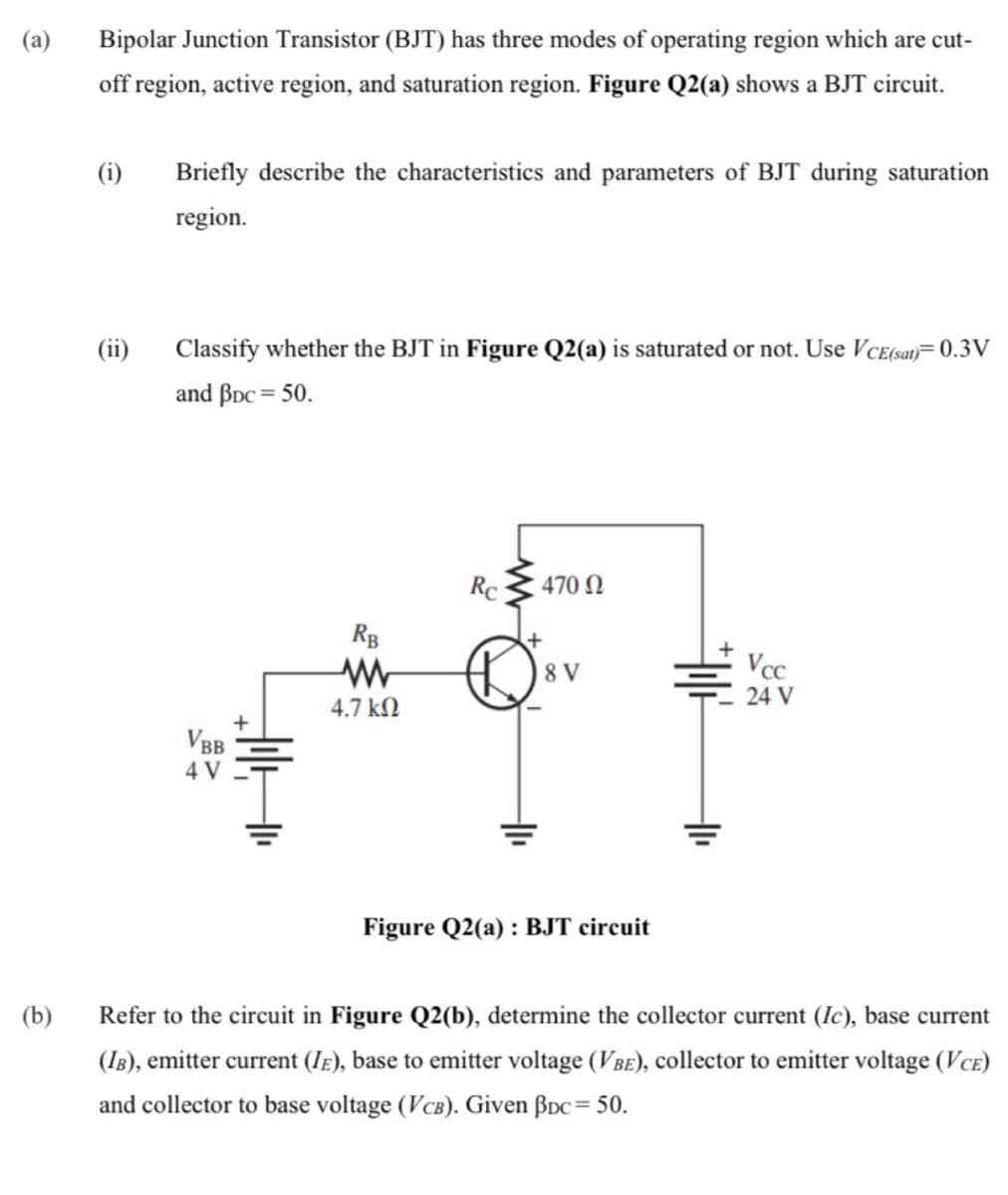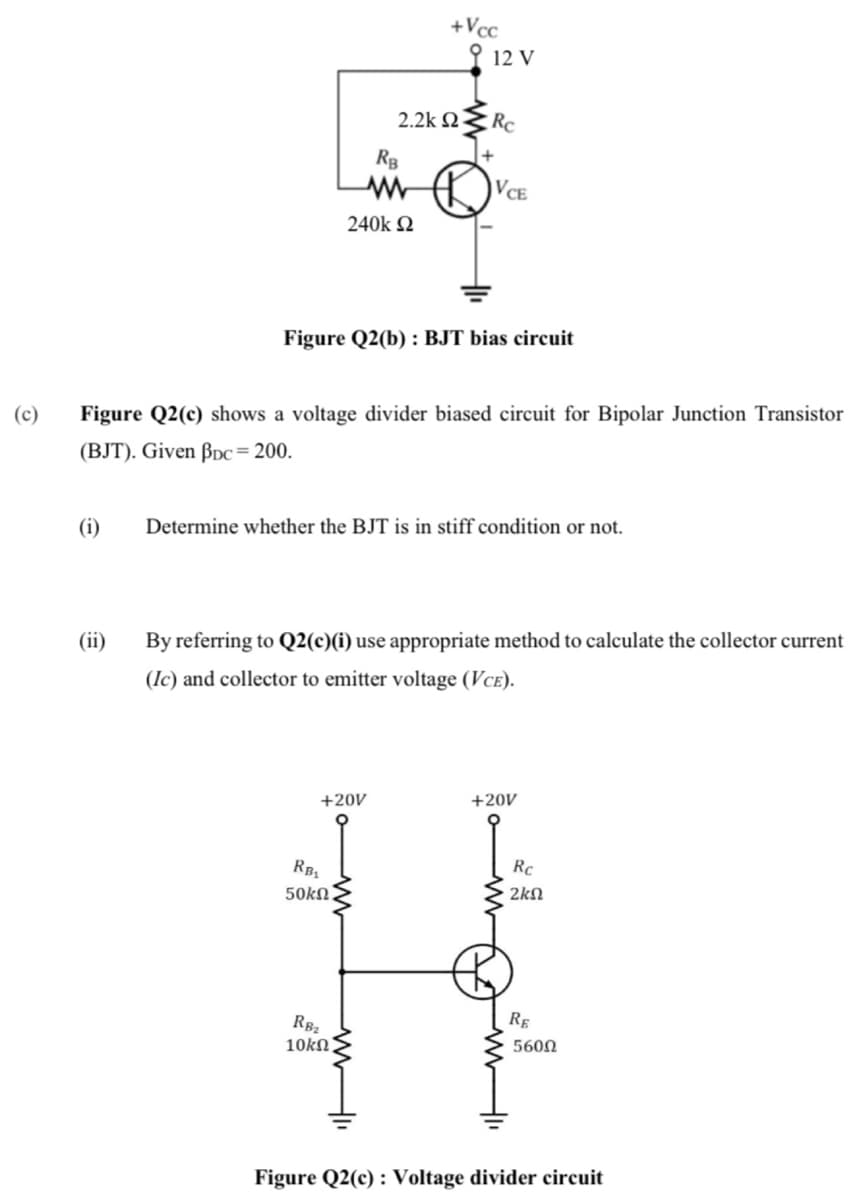(a) Bipolar Junction Transistor (BJT) has three modes of operating region which are cut- off region, active region, and saturation region. Figure Q2(a) shows a BJT circuit. (i) Briefly describe the characteristics and parameters of BJT during saturation region. (ii) Classify whether the BJT in Figure Q2(a) is saturated or not. Use VcE(sa)= 0.3V and BDc = 50. Rc 470 N RB Vcc 24 V 8 V 4.7 kN VBB 4 V Figure Q2(a) : BJT circuit (b) Refer to the circuit in Figure Q2(b), determine the collector current (Ic), base current (Is), emitter current (IE), base to emitter voltage (VBE), collector to emitter voltage (VcE) and collector to base voltage (VCB). Given Boc= 50. %3D
(a) Bipolar Junction Transistor (BJT) has three modes of operating region which are cut- off region, active region, and saturation region. Figure Q2(a) shows a BJT circuit. (i) Briefly describe the characteristics and parameters of BJT during saturation region. (ii) Classify whether the BJT in Figure Q2(a) is saturated or not. Use VcE(sa)= 0.3V and BDc = 50. Rc 470 N RB Vcc 24 V 8 V 4.7 kN VBB 4 V Figure Q2(a) : BJT circuit (b) Refer to the circuit in Figure Q2(b), determine the collector current (Ic), base current (Is), emitter current (IE), base to emitter voltage (VBE), collector to emitter voltage (VcE) and collector to base voltage (VCB). Given Boc= 50. %3D
Introductory Circuit Analysis (13th Edition)
13th Edition
ISBN:9780133923605
Author:Robert L. Boylestad
Publisher:Robert L. Boylestad
Chapter1: Introduction
Section: Chapter Questions
Problem 1P: Visit your local library (at school or home) and describe the extent to which it provides literature...
Related questions
Question

Transcribed Image Text:(a)
Bipolar Junction Transistor (BJT) has three modes of operating region which are cut-
off region, active region, and saturation region. Figure Q2(a) shows a BJT circuit.
(i)
Briefly describe the characteristics and parameters of BJT during saturation
region.
(ii)
Classify whether the BJT in Figure Q2(a) is saturated or not. Use VcE(sat)= 0.3V
and BDc = 50.
Rc
470 N
RB
8 V
Vcc
24 V
4.7 kN
VBB
4 V
Figure Q2(a) : BJT circuit
(b)
Refer to the circuit in Figure Q2(b), determine the collector current (Ic), base current
(IB), emitter current (Ie), base to emitter voltage (VBE), collector to emitter voltage (VcE)
and collector to base voltage (VcB). Given BDc= 50.

Transcribed Image Text:+Vcc
오 12 V
2.2k 2.
Rc
RB
VCE
240k Q
Figure Q2(b) : BJT bias circuit
(c)
Figure Q2(c) shows a voltage divider biased circuit for Bipolar Junction Transistor
(BJT). Given ßDc= 200.
(i)
Determine whether the BJT is in stiff condition or not.
(ii)
By referring to Q2(c)(i) use appropriate method to calculate the collector current
(Ic) and collector to emitter voltage (VcE).
+20V
+20V
RB
50kn.
Rc
2kN
RE
RB2
10kN.
5600
Figure Q2(c) : Voltage divider circuit
Expert Solution
This question has been solved!
Explore an expertly crafted, step-by-step solution for a thorough understanding of key concepts.
This is a popular solution!
Trending now
This is a popular solution!
Step by step
Solved in 5 steps with 3 images

Knowledge Booster
Learn more about
Need a deep-dive on the concept behind this application? Look no further. Learn more about this topic, electrical-engineering and related others by exploring similar questions and additional content below.Recommended textbooks for you

Introductory Circuit Analysis (13th Edition)
Electrical Engineering
ISBN:
9780133923605
Author:
Robert L. Boylestad
Publisher:
PEARSON

Delmar's Standard Textbook Of Electricity
Electrical Engineering
ISBN:
9781337900348
Author:
Stephen L. Herman
Publisher:
Cengage Learning

Programmable Logic Controllers
Electrical Engineering
ISBN:
9780073373843
Author:
Frank D. Petruzella
Publisher:
McGraw-Hill Education

Introductory Circuit Analysis (13th Edition)
Electrical Engineering
ISBN:
9780133923605
Author:
Robert L. Boylestad
Publisher:
PEARSON

Delmar's Standard Textbook Of Electricity
Electrical Engineering
ISBN:
9781337900348
Author:
Stephen L. Herman
Publisher:
Cengage Learning

Programmable Logic Controllers
Electrical Engineering
ISBN:
9780073373843
Author:
Frank D. Petruzella
Publisher:
McGraw-Hill Education

Fundamentals of Electric Circuits
Electrical Engineering
ISBN:
9780078028229
Author:
Charles K Alexander, Matthew Sadiku
Publisher:
McGraw-Hill Education

Electric Circuits. (11th Edition)
Electrical Engineering
ISBN:
9780134746968
Author:
James W. Nilsson, Susan Riedel
Publisher:
PEARSON

Engineering Electromagnetics
Electrical Engineering
ISBN:
9780078028151
Author:
Hayt, William H. (william Hart), Jr, BUCK, John A.
Publisher:
Mcgraw-hill Education,